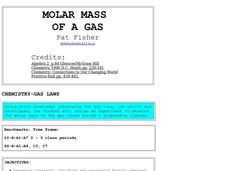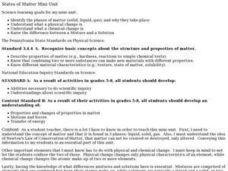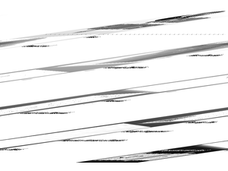Curated OER
What is a Chemical Reaction?-Evidence of Change
For this chemical reactions worksheet, students experiment with hydrochloric acid and copper (I) chloride to identify the types of reactions they undergo with various other substances. They also observe the law of conservation of mass...
Curated OER
Molar Mass
Students apply the ideal gas law and Dalton's Law of Partial Pressure to develop an experiment which determine the molar mass of butane from disposable lighters. In small groups, they develop a procedure and have it approved before...
Curated OER
Integrating Physics-Observing and Experimenting to Find Relationships
For this experimental relationship worksheet, students read about direct and indirect relationships between variables in experiments. They answer three questions about relationships between variables.
Curated OER
Science:Effects of Weathering
Seventh graders take an outdoor observation walk around the campus and take soil samples. Working in groups , they conduct experiments with rocks and soil that demonstrate the effects of different types of erosion.
Curated OER
Solids, Liquids, and Gases
Not many lessons on states of matter can hold a candle to this one! Junior chemists gauge the density of paraffin in both liquid and solid phases. They fill 60 mL syringes with different materials to experiment with compressibility and...
Curated OER
What Are Physical Changes in Matter?
In this matter worksheet, students write down 3 causes and effects of physical changes in matter. This worksheet is a graphic organizer.
Curated OER
What is a Physical Change in Matter?
In this matter worksheet, students complete a graphic organizer by writing in 1 thing that causes a physical change in matter and 3 effects this has on matter.
Curated OER
Newton's Third Law of Motion
Seventh graders are introduced to Newton's Third Law of Motion. For this physics lesson students examine the concept of thrust as one of the forces acting on aircraft.
Virginia Department of Education
States of Matter
Scientists have been studying exothermic reactions before they were cool. The lesson plan begins with a discussion and a demonstration of heat curves. Scholars then determine the heat of fusion of ice and the heat needed...
Curated OER
MTV no PTV
Students study the gas laws in particular the three variables; pressure, temperature and volume. In this gas laws instructional activity students complete an activity and discuss their findings.
Curated OER
Chemistry: Egg Sucking Experiment
Pupils discover simple gas laws by observing an egg sucked into an Erlenmeyer flask. When the flask is warmed, the egg is placed atop it. when both are placed in ice water, the egg slips into the flask. The procedure is then reversed....
Curated OER
Action-Reaction! Rocket
Students construct a rocket from a balloon propelled along a guide string. They use this model to learn about Newton's three laws of motion, examining the effect of different forces on the motion of the rocket. They measure the distance...
Curated OER
Cycling of Matter and Energy
These twenty various types of questions related to the cycling of matter and energy require students to match each definition in column 1 with the correct vocabulary term from column 2. Then, students explain what is being demonstrated...
Curated OER
Conservation of Mass
In this conservation of mass activity, students experiment with vinegar, baking soda, a balloon and a flask. They compare the mass of the closed system of reactants before the experiment to the mass of the products after the experiment...
Curated OER
States of Matter Mini-Unit
Students identify he phases of matter (solid, liquid, gas), and why they take place. They comprehend what a physical change is and what a chemical change is. Students know the difference between a Mixture and a Solution.
Curated OER
Pop Rockets
Students work together to design and build a paper rocket. They place a propellant in the contraption to make it fly. They discover Newton's third law of motion.
Curated OER
Lift and Drag: Principles of Flight and the Soaring Imagination
Students construct models of early gas balloons and gliders. In this balloon and glider lesson, students create models of early gas balloons and gliders, discover how the forces of lift and drag effect aircraft in flight, and put on...
Curated OER
Where My Peeps At?
Students conduct a series of activity that demonstrates Charles' and Boyle's Law. In this chemistry lesson plan, students determine the relationship among pressure, volume and temperature. They solve problems using mathematical...
Curated OER
Chemical Equations and Reactions
Graphic organizers, photos, diagrams, and text bring the world of chemical reactions to life. By viewing this presentation, young chemists learn how to recognize when a chemical reaction has occurred, and how to balance chemical...
Curated OER
Now, Take a Deep Breath
Students define several laws of pressure and see how they relate to scuba diving. In this ocean explorer lesson students answer questions and complete an activity.
Curated OER
Potato Chips Fragility
Learners investigate why some potato chips crumple faster than others. In this physics lessons, students relate the cooking time to potato's fragility. They write a lab report about their findings.
Curated OER
Describing Chemical Reactions
In this chemical reactions instructional activity, students fill in 12 blanks with the appropriate terms related to chemical reactions. They also indicate if 4 statements are true or false and match 7 words with their descriptions....
Curated OER
Aqua-Thrusters!
Students construct their own rocket-powered boat called an "aqua-thruster." These aqua-thrusters will be made from a film canister and will use carbon dioxide gas - produced from a chemical reaction between an antacid tablet and water -...
Curated OER
Powering a Green Earth
Students compare and contrast renewable and nonrenewable energy. In this environmental science instructional activity, students discuss the importance of going green. They identify the different components in a power grid system.

























